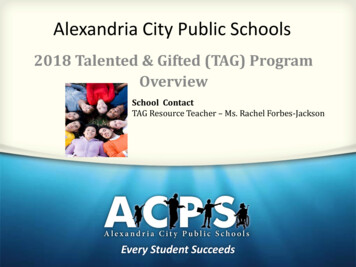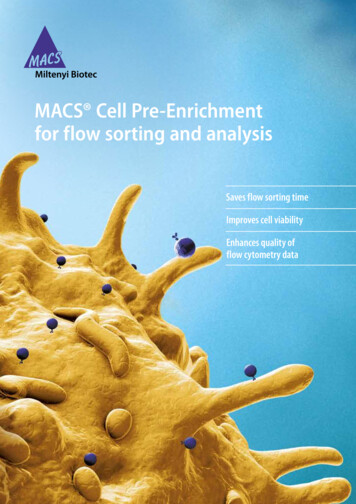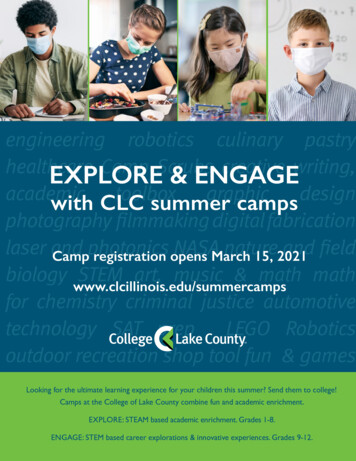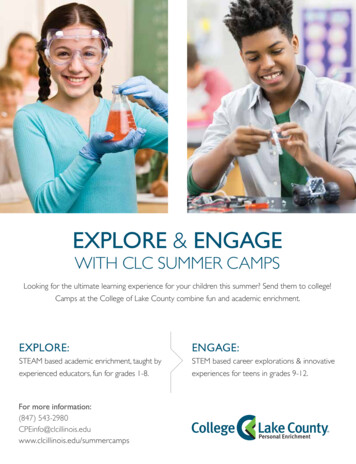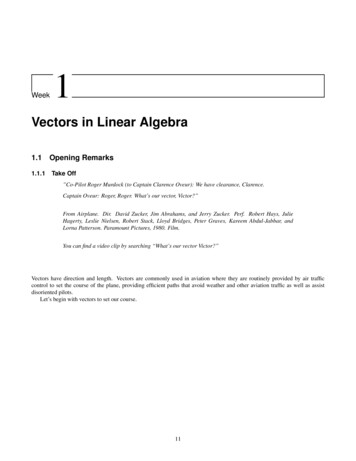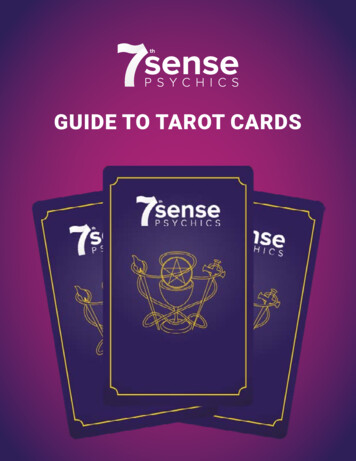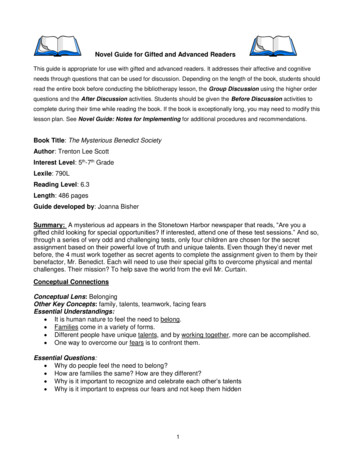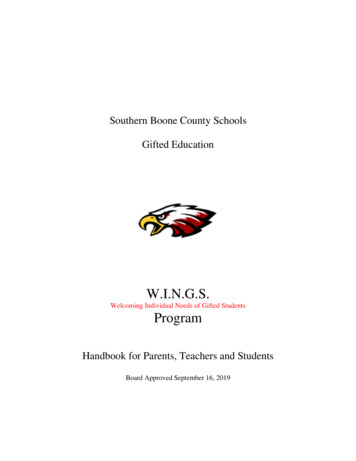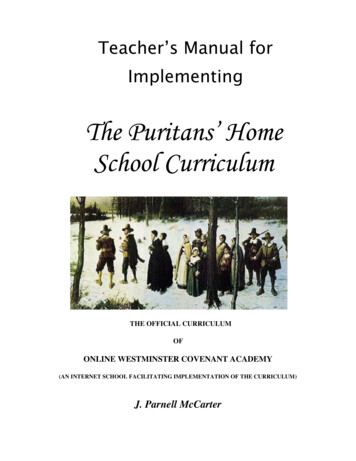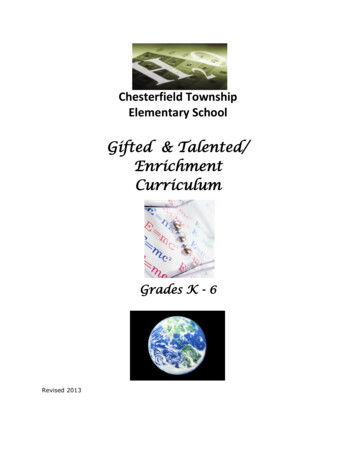
Transcription
Chesterfield TownshipElementary SchoolGifted & Talented/EnrichmentCurriculumGrades K - 6Revised 2013
Table of ContentsRationale and Philosophy3Units of Study by Grade LevelKindergartenGrade 1Grade 2Grade 3Grade 4Grade 5Grade 65152535455464Differentiation Guide72Curriculum Connections75Pacing Guide782
Rationale and PhilosophyNote on Curriculum FormatThe Chesterfield School District has adopted the Understanding by Design (UbD) format toorganize the Curriculum Standards. Overall Unit topics are thus seen as guiding principles,specifying the “Big Idea” which each unit addresses. These overall learning goals are includedthe sections labeled Stage 1 below. Next, in stage 2, are the various ways that the mastery ofguiding ideas are assessed. Finally, in the sections labeled stage 3, teachers can then choosefrom a variety of lessons or formats which address the particular needs and interests of the class,as they address the learning goals.StandardsWhile the NJ state department of education has not specified any set curriculum guidelines forGifted and Talented education, the Chesterfield Township School District had incorporatedvarious State Curriculum into our framework. Significantly, the state 21st Century Life andCareers Standards have been integrated, as well as standards from the Common Core Literacyand Math, and other subject area standards. These include standards in Health/PhysicalEducation, Art, Music, Social Studies, and Science.Rationale and PhilosophyThe Chesterfield Elementary School Gifted & Talented / Enrichment program is challenging andmeaningful to our students. The program supports a learning environment that encouragesstudents to reach their highest potential. The goal of the program is to allow students to engagetheir creativity, strengths, and abilities to the greatest extent possible. We focus on promotinghigh-level thinking and developing students who are well-rounded, 21st century learners. Theunits of study are project-based and thematic, and they allow for discovery, open-endedness andfreedom of choice. The students must use complex skills, such as problem-solving,collaboration/teamwork, communication and critical thinking. Students use current technology toconduct research and complete tasks. The program uses a wide range of instructional strategies,supporting resources, and grouping options throughout the year. The program allows for the3
identification of unique patterns of strengths, abilities, and interests, which are sued to furtherfocus instruction and build on existing talents. This focus on individualized learning profile isintegrated into the first unit for each grade and identified strengths are then used to guide furtherinstruction.Inclusion Focus: EnrichmentIn whole class activities, the G&T curriculum promotes and facilitates constructivist,participatory, self-inquiry, and cooperative learning experiences. Many units encompass crosscurricular activities. The curriculum is designed to include differentiation, which enables theteachers to easily adapt their teaching methods to parallel gifted students’ needs. Often this isconnected with ongoing work in the general education classroom. The G&T content also givesstudents choices about topics to explore in greater depth and the process creates tasks based onindividual learning styles. Both the classroom teacher and the Gifted and Talented teacher workcollaboratively to provide instruction.Pull-Out Focus: Project-based units of studyWhen meeting in small groups, curricular units of study emphasize creative thinking, authentic,real-life problem solving, communication skills both oral and written, higher-order/analyticalthinking skills, and cooperative learning. Students’ strengths, interests, and talents guide theselection of the units covered. All units include self-directed learning activities, instructionalmaterials and curricula that are challenging to each student. Each unit also provides a variety ofindividual and group oriented projects that are designed to promote hands-on research andinvestigative decision making.4
KindergartenUnit 1:Getting to Know ME3 weeksSTAGE 1 – DESIRED RESULTSEssential Questions:··········What do I enjoy doing in my free time?How am I NOW?What are things that I love?What kinds of things interest me?What are things that I do not like to do?What am I good at?Who do I like to spend time with and where?What do I want to be when I grow up?What are my short-term goals for this school year?What are my long-term goals for my academic future?Enduring Understandings:·····Each person is unique and has different interests and goals for themselves.To be successful in life, we must have a vision of what we would like to achieve.Each person has various abilities and strengths and it is okay for people to be strong inone area but not in another.Understand different career descriptions that may or may not interest students.Various individuals shape the way we think and act.Objectives - Students will be able to:· Describe what they enjoy doing.· Identify their particular interests and talents by analyzing results of an interest inventory· Describe the characteristics of a chosen occupation· Collaborate with peers about similar interestsStandards21st Century Standards· 9.1.8.C.3 Model leadership skills during classroom and extra-curricularactivities.· 9.1.4.D.2 Express needs, wants, and feelings appropriately in varioussituations.5
STAGE 2 – ASSESSMENT EVIDENCEMay include by not limited to:··········Formal and informal teacher observationsDiscussionsTeacher questioning and student oral responsesPerformance assessmentsRubricsLesson assignments and recordsCompleted projectsClass presentationsSelf-assessmentsPeer evaluationsSTAGE 3 – Suggested Activities and ResourcesSuggested Activities···Complete an interest inventoryInterview family members or friends that have had a positive impact on student’s lives.(sample questions could include occupation-related, morals/values, advice about life,educational-related)Perform activities such as role-playing, dressing up, and acting the part of an occupationof interestDifferentiationInterest inventory can be scaffolded based on reading and writing levelsGive students the option of acting out a profession, drawing, writing or speakingResourcesHelpful websites: Personality Test - http://www.personalitylab.org ; Bureau of Laborand Statistics –A to Z list of careers - http://www.bls.gov/k12/aclist.htm ; Career InterestInventory ads/CareerInterestInventory.pdf ;Differentiated Instructional Strategy Interest Inventory egies/DI%202012/Interest%20Inventory.pdf6
KindergartenUnit 2:Economics – People/Work8 weeksSTAGE 1 – DESIRED RESULTSEssential Questions:·····Why do people work?What are the benefits and challenges of working?What is the difference between a “want” and a “need”?How do people survive in the world if no one is taking care of them?Why do people save money?Enduring Understandings:·····People have many different kinds of jobs.People work to earn money.You need things to survive. A want is an item you would like to have but do not need.People use money to buy things that they want or need.People save money to buy things they might need in the future.Objectives - Students will be able to:·····Understand that there are different kinds of jobs and understand that a product issomething made by humans, machines, or nature.Observe that everyone has needs and wants and understand the difference between needsand wants.Explain how basic needs for food, clothing, and a place to live can be met.Recognize that people meet their needs by buying goods and services and understand thedifference between goods and services.Understand that people exchange money for goods and recognize why people savemoney.Standards21st Century Standards· 9.2.4.A.1 Explain the difference between a career and a job, identifyvarious jobs within the community and the related earnings.7
STAGE 2 – ASSESSMENT EVIDENCEMay include by not limited to:··········Formal and informal teacher observationsDiscussionsTeacher questioning and student oral responsesPerformance assessmentsRubricsLesson assignments and recordsCompleted projectsClass presentationsSelf-assessmentsPeer evaluationsSTAGE 3 – Suggested Activities and ResourcesSuggested Activities· Recognize the characteristics of a product and correctly organize them. For example,display things that are electric and things that aren’t electric and have the studentscategorize them.· Create a “Needs and Wants” Collage – Cut out pictures and place them in the correctcategory.· “Water is your best friend” lesson· Brainstorm a list of individual jobs and discuss· Complete goods and services worksheet· Barter and trade different objects with partners and share how the students felt about theactivityDifferentiation· Use pictures to go along with discussions for visual and auditory learners.· Have students act out different careers for more active students· Vocabulary reinforcement· Reduce the amount of items to categories for students who can be overwhelmed with toomany choicesResources· http://www.dsrsd.com/img/img lesson plans/Kindergarten Lesson Plan.pdf· Grow Healthy instructional materials· ods-and-services WMZTR.pdf· ABC’s of saving - lesson.php?lid 414&type educator· “Why We Save” lesson - http://ecedweb.unomaha.edu/lessons/savek-2.pdf8
KindergartenUnit 3:Exploring with the Senses6 weeksSTAGE 1 – DESIRED RESULTSEssential Questions:·······What are the 5 senses?How do I use the 5 senses?How can using the 5 senses help me?What happens if I lose one of my senses?How do objects look up close and from far away?How can you group objects by their properties?How are materials alike and different?Enduring Understandings:····The 5 senses help us to explore the world we live in.Some people have lost one or more sense, which in turn, may heighten another sense.All individuals can adapt to their environment using one or more of their senses.Objects and materials can be grouped by their properties.Objectives - Students will be able to:····Identify objects and discuss the kinds of information that each sensory organ provides.Conclude that information gathered about a nearby object and the same object seen at adistance may varyClassify objects based on their observable properties.Observe properties of objects and classify the objects into groups based on the materialsfrom which they are made.Standards· 5.1.4.A.3 – Use scientific facts, measurements, observations, and patterns in nature tobuild and critique scientific arguments.· 5.1.4.B.3 – Formulate explanations from evidence9
STAGE 2 – ASSESSMENT EVIDENCEMay include by not limited to:··········Formal and informal teacher observationsDiscussionsTeacher questioning and student oral responsesPerformance assessmentsRubricsLesson assignments and recordsCompleted projectsClass presentationsSelf-assessmentsPeer evaluationsSTAGE 3 – Suggested Activities and ResourcesSuggested Activities· Senses on the Farm – practice naming and describing the five senses as they sing versesof “Old MacDonald Had a Farm”· Telling a Story – creating children and animals on a piece of poster-board whiledescribing the senses used and classifying the kinds of information that each sensoryorgan provides.· Playing “I Spy” with the five senses – playing a game in which the students focus on anddescribe objects that are close up and far away· Classify scents, using the sense of smell and identify scents that are associated withdifferent objects.· Observe properties of objects and classify the objects into groups based on the materialsfrom which they are made.· Grouping objects by touch – using their sense of touch, students examine objects withdifferent properties, such as hardness, texture, etc. Place objects in different bags andhave the students draw a picture of what they think they are touching and then reveal theactual object.Differentiation· Have students work individually and in groups throughout the unit· For students who are able to write, they can write their own story while the others workwith the teacher as a groupResources· “I Spy” books· Various objects that smell different, some with very pungent smells· Various objects with different touchable properties, such as pencils, squishy balls,cooked spaghetti, blocks, something fuzzy, etc.· Helpful websites: 5 senses activities - s-activities-for-kids.html10
KindergartenUnit 4:Friends and Family – Culture8 weeksSTAGE 1 – DESIRED RESULTSEssential Questions:···What does it mean to be a friend?What different traditions and celebrations are there in the world?What are the roles of people in their family?Enduring Understandings:···People celebrate different holidays around the world.A good friend is caring and helpful.People serve different roles in the community.Objectives - Students will be able to:··Explain why different holidays are celebrated worldwide.Differentiate between the actions of a good friend and one who is not a good friend.Standards· 9.1.4.D.3 – Demonstrate an awareness of one’s own culture and other cultures duringinteractions in and outside the classroomSTAGE 2 – ASSESSMENT EVIDENCEMay include by not limited to:··········Formal and informal teacher observationsDiscussionsTeacher questioning and student oral responsesPerformance assessmentsRubricsLesson assignments and recordsCompleted projectsClass presentationsSelf-assessmentsPeer evaluations11
STAGE 3 – Suggested Activities and ResourcesSuggested Activities· Try foods from different cultures· Discuss what it means to be a good friend· Read books about different holidays and create a craft related to the holiday· Draw a family treeDifferentiation· Give students the option to act out, share aloud or draw a picture of what is agood friend· Group students who may need extra help with the family tree together in order togive extra assistanceResourcesBook: Children Just Like Me by Anabel Kindersley12
KindergartenUnit 5:Where We Live8 weeksSTAGE 1 – DESIRED RESULTSEssential Questions:·····What types of homes do people and animals live in?What is a neighborhood?How are the city and the country different? The same?How do people get from place to place?What is Earth’s surface like?Enduring Understandings:·····People in different locations live in homes of different sizes and that are made ofdifferent materials. They can look very different than the homes in your neighborhood.Animals make their homes from the resources in their area.A neighborhood is a place where groups of families live, work and play together.In a city, there are more people living closer together, more businesses and heavy traffic.In the country, there is more open land, people live further apart and you can see moreanimals.People use transportation such as cars, boats, buses, trains and planes to get from oneplace to another. They may travel for work, to visit people or just to explore a new place.Earth’s surface is mostly covered by water. It has 7 continents.Objectives - Students will be able to:·····Identify different types of homesUnderstand what is a neighborhood and why we live in neighborhoodsCompare and contrast the city to the countryIdentify different types of transportationDescribe Earth’s surfaceStandards· 5.1.4.B.2 – Measure, gather, evaluate, and share evidence using tools and technologies· 6.1.4.B.7 – Explain why some locations in New Jersey and the United States are moresuited for settlement than others.13
STAGE 2 – ASSESSMENT EVIDENCEMay include by not limited to:··········Formal and informal teacher observationsDiscussionsTeacher questioning and student oral responsesPerformance assessmentsRubricsLesson assignments and recordsCompleted projectsClass presentationsSelf-assessmentsPeer evaluationsSTAGE 3 – Suggested Activities and ResourcesSuggested Activities· Matching game- match animals to their homes· Draw a picture of your home· Carton City- using empty cartons create a 3D city· Create interview questions for a neighborhood community worker such as a police manor teacher· Cut out pictures and decide if they should go under “City” or “Country”· Survey the students on how they get to school. Create a bar graph with the results.· Use clay to create models of different types of landforms such as a mountain or plateauDifferentiation· Give students a graphic organizer for survey· Pair students together who may need extra help with another student for the “City” or“Country” activityResources· Animal/Home Matching Game14
1st GradeUnit 1:Getting to Know ME3 weeksSTAGE 1 – DESIRED RESULTSEssential Questions:···········What do I enjoy doing in my free time?How am I NOW?What are things that I love?What kinds of things interest me?What are things that I do not like to do?What am I good at?Who do I like to spend time with and where?Who has shaped my thinking and how can I model that behavior?What do I want to be when I grow up?What are my short-term goals for this school year?What are my long-term goals for my academic future?Enduring Understandings:·····Each person is unique and has different interests and goals for themselves.To be successful in life we must have a vision of what we would like to achieve.Each person has various abilities and strengths and it is okay for people to be strong inone area but not in another.Understand different career descriptions that may or may not interest students.Various individuals shape the way we think and act.Standards9.1.8.C.3 Model leadership skills during classroom and extra-curricular activities.9.1.4.D.2 Express needs, wants, and feelings appropriately in various situations.Objectives - Students will be able to:····Describe what they enjoy doing.Identify their particular interests and talents by analyzing results of an interest inventoryDescribe the characteristics of a chosen occupationCollaborate with peers about similar interests15
STAGE 2 – ASSESSMENT EVIDENCEMay include by not limited to:··········Formal and informal teacher observationsDiscussionsTeacher questioning and student oral responsesPerformance assessmentsRubricsLesson assignments and recordsCompleted projectsClass presentationsSelf-assessmentsPeer evaluationsSTAGE 3 – Suggested Activities and ResourcesSuggested Activities· Complete an interest inventory· Interview family members or friends that have had a positive impact on student’s lives.(sample questions could include occupation-related, morals/values, advice about life,educational-related)· Research an occupational field that interests the student and give a presentation.· Perform activities such as role-playing, dressing up, and acting the part of an occupationof interestDifferentiationInterest inventory can be scaffolded based on reading and writing levelsGive students the option of acting out a profession, drawing, writing or speakingResources· Helpful websites: Personality Test - http://www.personalitylab.org ; Bureau of Laborand Statistics –A to Z list of careers - http://www.bls.gov/k12/aclist.htm ; Career InterestInventory ads/CareerInterestInventory.pdf ;Differentiated Instructional Strategy Interest Inventory egies/DI%202012/Interest%20Inventory.pdf16
1st GradeUnit 2:All Kinds of Jobs6 weeksSTAGE 1 – DESIRED RESULTSEssential Questions:·····What are jobs in the community?What are service jobs?How are goods made? Who makes them?How do people exchange goods and services?How can technology help make work easier? What challenges may it cause?Enduring Understandings:·····Different jobs provide different benefits to the community.Service jobs directly help people in the community such as a police officer and a firefighter.People use money to purchase goods or services.Various jobs are needed to create all the things you are able to purchase or services youmay buy.Technology and other inventions have made work easier but it can also have drawbacks.Objectives - Students will be able to:····Identify a variety of jobs (services jobs and other jobs) and describe the responsibilitiesof the job and the benefits to the communityDescribe how certain jobs are made. Identify the title of the person who makes theseobjects.Explain how people use money to purchase goods and services.Differentiate between the positive and negatives of technological advancesStandards·9.2.4.A.1 Explain the difference between a career and a job, identify various jobs withinthe community and the related earnings.17
STAGE 2 – ASSESSMENT EVIDENCEMay include by not limited to:··········Formal and informal teacher observationsDiscussionsTeacher questioning and student oral responsesPerformance assessmentsRubricsLesson assignments and recordsCompleted projectsClass presentationsSelf-assessmentsPeer evaluationsSTAGE 3 – Suggested Activities and ResourcesSuggested Activities· Have students draw a picture of themselves in a profession. Have them explain why theywould be good at this job and why they want to do this job.· Have students act out a job and others in the class can guess who they are.· Create an advertisement for a product· Students will list how they spent money. As a homework assignment, they can write howmoney has been spent in the home.· Compare tools used in the past in a certain profession to the tools used today.Differentiation· Bring in tools form the past if possible for students who are more visual and hands onlearners· For students who feel overwhelmed by too many choices, give them a choice of two orthree products that they can create an advertisement for· Give students the option to tell why they would excel in a career orally or throughwritingResources· Hot on the Trail board game to distinguish between wants and needs· Books about careers in the classroom for students to read through· Spending Money Worksheet18
1st GradeUnit 3:Magnets6 weeksSTAGE 1 – DESIRED RESULTSEssential Questions:·····What types of items can be attracted to a magnet?What is a magnetic force?Where are magnets strongest?What do the poles of magnets do?What is a magnetic field?Enduring Understandings:····Most metal objects are attracted to a magnet. Non-metal objects are not attracted to amagnet.Magnets can be of varying strength.All magnets are strongest at the poles.Magnets have a force field around them which can attract objects without touching.Objectives - Students will be able to:···Classify objects that will and won’t be attracted to a magnet.Explain a magnetic force field and poles.Create ways to identify stronger and weaker magnets.Standards· 5.1.8.B.2 – Gather, evaluate, and represent evidence using scientific tools, technologies,and computational strategies.19
STAGE 2 – ASSESSMENT EVIDENCEMay include by not limited to:··········Formal and informal teacher observationsDiscussionsTeacher questioning and student oral responsesPerformance assessmentsRubricsLesson assignments and recordsCompleted projectsClass presentationsSelf-assessmentsPeer evaluationsSTAGE 3 – Suggested Activities and ResourcesSuggested Activities· Make predictions about attraction and then test those predictions. Afterwards classifyinto two groups: attracted to a magnet and not attracted to a magnet.· Testing magnetic force: place a paper clip and magnet on a string. Place an objectbetween the clip and magnet. Record what happens. Ask why this happens?· See how many paperclips the middle, side and poles can hold. Make a bar graph with theresults. Discuss.· Make magnetic patterns using bar magnets.· Have students try to make a magnet move on top of a thin book by moving a magnetunderneath the book.Differentiation· Let students work individually, in pairs and in whole group throughout the lessonResources· Book: Marta’s Magnets By Wendy Pfeffer· Interactive CD-ROM : I Love Science – Magnet Activity20
1st GradeUnit 4:Changes Over Time8 weeksSTAGE 1 – DESIRED RESULTSEssential Questions:·····What was the Earth like a long time ago?What were dinosaurs like? How big were they?What can we learn from fossils?How do fossils form?What did extinct animals eat?Enduring Understandings:·····Describe the Earth in the distant past.Dinosaurs were very large creatures but there were also some smaller dinosaurs.Fossils can teach us about animals and plants that no longer exist.Fossils are left in rocks and earth using pressure.Animal’s teeth give clues to their diet.Objectives - Students will be able to:····Collect, record and interpret data about dinosaursInfer the size and other information from fossils and bonesUnderstand we can learn about the past from finding bones, teeth, and fossils.Use bones, teeth and fossils to make inferences to diet, size, and other characteristics.Standards· 6.2.8.D.1.c – Explain how archaeological studies are used to develop and enhanceunderstanding of life prior to written records· 5.3.2.E.2 – Describe how similar structures found in organisms (e.g., eyes, ears, mouth)have similar functions and enable those organisms to survive in different environments.21
STAGE 2 – ASSESSMENT EVIDENCEMay include by not limited to:··········Formal and informal teacher observationsDiscussionsTeacher questioning and student oral responsesPerformance assessmentsRubricsLesson assignments and recordsCompleted projectsClass presentationsSelf-assessmentsPeer evaluationsSTAGE 3 – Suggested Activities and ResourcesSuggested Activities· Create a diorama of the Earth as it looked long ago.· Make a model of a dinosaur in comparison to a familiar animal that lives today.· Study how bones and fossils are found.· Compare the student’s skeleton to the skeleton of a dinosaur. Discuss what inferencesthey can make about the dinosaur.· Create a fossil using plaster of Paris. Compare this to a real fossil.· Create a menu for dinosaurs dividing the menu into herbivore and carnivore choices.Differentiation· Use fossils (G&T Room) for tactile learners· Group students who will need extra assistance with creating their own fossil· vocabulary reinforcement· Have students choose to work in pairs or alone for the Menu activityResources· Collection of fossils22
1st GradeUnit 5:Citizens8 weeksSTAGE 1 – DESIRED RESULTSEssential Questions:·····Why do we have laws?What is a leader?Why do people vote?What rituals/symbols are related to citizenship?What makes a person a good citizen? How can you be a good citizen?Enduring Understandings:·····Laws are rules people follow to keep them safe.A leader helps to make laws.People vote to make decisions that will make the majority of people satisfied.People make pledges and sing certain songs to show that they are all citizens of oneplace. People hang flags as a symbol that they are a citizen of a given place.A good citizen is truthful, believes in treating others equally and takes responsibility forthe people around them.Objectives - Students will be able to:·····Explain the need for rules in the classroom and other settings.Identify leaders in the school and government.Identify and use voting as a way to make a decisionIdentify symbols and rituals used in the United States to show patriotismIdentify the characteristics that make a good citizenStandards6.3.4.A.1 Evaluate what makes a good rule or law.23
STAGE 2 – ASSESSMENT EVIDENCEMay include by not limited to:··········Formal and informal teacher observationsDiscussionsTeacher questioning and student oral responsesPerformance assessmentsRubricsLesson assignments and recordsCompleted projectsClass presentationsSelf-assessmentsPeer evaluationsSTAGE 3 – Suggested Activities and ResourcesSuggested Activities Discuss classroom rules and relate those to rules outside of school. Create postersof students following the rules and a caption of the rule and why it is important tofollow this rule. Have students draw themselves in a leading role. Have them write a shortsentence about how they are leading. Have the students vote democratically on a choice that will be implemented thatday. For example: Should we have 10 minutes of playing 7-UP or 10 minutes todo a short art project? Research NJ State symbols. Present them to the class. Design a postage stamp of a good citizen. In a short presentation, explain whythey choose this person.Differentiation· For students who struggle with writing, ask them to tell you orally and recordtheir answer for them· For students who struggle with choices, tell them what state symbol they willresearch· Give a graphic organizer for the research paper for those who need guidingquestionsResources NJ State Symbols: http://www.njleg.state.nj.us/kids/1280njsym.asp NJ State flag and Seal: http://www.njleg.state.nj.us/kids/index.asp24
2nd GradeUnit 1:Getting to Know ME3 weeksSTAGE 1 – DESIRED RESULTSEssential Questions:···········What do I enjoy doing in my free time?How am I NOW?What are things that I love?What kinds of things interest me?What are things that I do not like to do?What am I good at?Who do I like to spend time with and where?Who has shaped my thinking and how can I model that behavior?What do I want to be when I grow up?What are my short-term goals for this school year?What are my long-term goals for my academic future?Enduring Understandings:·····Each person is unique and has different interests and goals for themselves.To be successful in life we must have a vision of what we would like to achieve.Each person has various abilities and strengths and it is okay for people to be strong inone area but not in another.Understand different career descriptions that may or may not interest students.Various individuals shape the way we think and act.Objectives - Student
Education, Art, Music, Social Studies, and Science. Rationale and Philosophy The Chesterfield Elementary School Gifted & Talented / Enrichment program is challenging and meaningful to our students. The program supports a learning environment t


